#Thecodontion
Explore tagged Tumblr posts
Note
Another thing is that old-timey dinosaurs didn't move like real animals. They moved like monsters. When I look at those weird lumpy rexes, I can't imagine how they'd move, beyond "guy in a T. rex costume", like a weird awkward waddle. Looking at the more accurate ones, it's easy to understand how they move and what they'd look like in motion.
I've never heard of Dollo; who was he and what was his bad theory?
Yeah that's fair, it's annoying to see the man moving
that said, the raptors in the original JP were also men in a suit - but they compensated to make it look closer to natural
Dollo was a scientist in the 1800s who created a theory that organisms can't re-evolve structures they lost. he didn't know genetics, so he didn't know that features can be turned on and off and thus it can be possible to re-evolve lost structures.
but, because of that theory, he and others decided birds couldn't be dinosaurs. this was because, at the time, we had no evidence of a dinosaur furcula (wishbone) - or, at least, we thought we had no evidence of one. We did, however, have "thecodonts" (early archosaurs) with wishbones - meaning that, if birds evolved from dinosaurs, they would have had to re-evolve the wishbone
turns out a) non-avialan dinosaurs did have wishbones, they just don't fossilize well b) we did have some, we just misidentified them and c) yeah you can redevelop things actually
so we went from birds being dinosaurs being the best supported hypothesis to almost no one believing it within a few years at the end of the 1800s
leading to the "dinosaur dark ages" (dinosaurs are slow evolutionary failures) that was the first 60 years of the 20th century
so, yeah. we can blame dollo, 100%, for everyone being ignorant about dinosaurs.
114 notes
·
View notes
Text
only using animals completely diverged from extant reptiles here, also I know thecodont is an outdated term but I'm using it for convenience's sake, also if you don't know what I mean by the second to last choice, I mean drepanosaurs and assorted gliding lizards (also weird is used in a positive manner here)
236 notes
·
View notes
Text
Dragon Care: Druddigon
Druddigon are one of the more difficult dragons to care for due to being ectotherms and having special temperature needs. Some variants are dragon/rock type, and those can generally be assumed to need less food overall on account of having a slower metabolism as a rock type--but bear in mind druddigon still get very large, averaging a little over five feet tall, and as such will require quite a bit of food to begin with.
As an egg:
A druddigon egg should be kept under a heat lamp, with the surrounding air temperature in the range of 90-100 degrees F (32-38 C). High temperatures will help the growing dragon develop faster, but the egg will still need about six months of "cooking" time before it is ready to hatch.
As a juvenile:
A baby druddigon that is kept sufficiently warm will be very active. If you are purchasing, adopting, or catching one as a juvenile, look for bright eyes and a willingness to chase things and play. They should be regularly allowed to play on sand, rock, or concrete; this will allow their skin to harden faster.
Druddigon are partial autotrophs and therefore gain some of their energy from heat lamps/sunlight, but they also supplement their diet with small animals and pokémon--basically whatever they can catch and fit in their mouths. Thecodont dentition and strong jaw muscles mean even a juvenile can bite hard enough to snap bones, including yours if improperly trained. Gentle jaw training should be a priority for a druddigon of any age, not just to avoid injuries but also to encourage them be more cooperative if their teeth need to be cleaned.
Druddigon are carnivores and should be offered fresh meat once a week. More than this is overfeeding if they are already healthy; a slow metabolism means they don't need to eat as often as other dragons, and as stated earlier, those that are dragon/rock type need to be fed even less.
As an adult:
A druddigon's skin hardens throughout its life, until it eventually solidifies completely when the dragon dies. Druddigon will slow down as they age, but their lifespans reach into the hundreds of years, so despite needing less attention than other higher-energy or more social dragons, they are still a big commitment. You should always keep a heat source or basking spot accessible for them so they can regulate their internal temperature.
If a druddigon cools enough that it can't move, don't worry. Apply a light and heat source and it should warm back up enough to move again. Druddigon in an immobile state are essentially in hibernation and can go years without eating or drinking.
5 notes
·
View notes
Text

Running Thecodontosaurus antiquus, a basal sauropodomorph from the Late Triassic (Rhaetian) of Southern England. This reptile was described in 1836 from finds from a quarry in present-day Bristol. Then it was classified as squamate, and the name ("lizard with teeth in sockets" in translation) emphasized the differences in the fastening of teeth). It was only in 1870 that Thomas Huxley attributed Thecodontosaurus to dinosaurs (now it is obvious that all dinosaurs had thecodont teeth attachment). Later, many bones were found in the "fissure fillings", some of which were destroyed during the bombing of Bristol. Today, about 245 fragmentary fossils are known, from which it is possible to make up almost an entire skeleton. In 1891, the supposedly Australian material of Thecodontosaurus was separated into the genus Agrosaurus, but it turned out that it was incorrectly labeled. One juvenile specimen was describes as the genus Pantydraco in 2007. Thecodontosaurus was a small long-tailed dinosaur, the largest specimens were 2.5 m in length (and the average length was only 1.2 m). Michael Benton noted in 2000 that there was a robust morph among Thecodontosaurus. This may indicate sexual dimorphism.
Here I tried to convey the scaly integument with vertical hatching. Let's see how this method will manifest itself in future works. :) The filaments are speculative.
Black ballpoint pen and black colored pencil, 2023.
#thecodontosaurus antiquus#thecodontosaurus#pantydraco#basal sauropodomorph#triassic dinosaurs#late triassic#paleoart
13 notes
·
View notes
Note
Sharks produce teeth throughout their lifetime. Great. Why don't we have that?? Mere 7k baach jaatey
ok you want the actual answer or.........
the real answer is *drum roll* LUCK (or lack thereof) as far as i know (most likely, im not 100percent sure)
our teeth and sharks' teeth are examples of convergent evolution. two different things with two different origins coincidentally doing the same job. one type is thecodont, aka teeth are tightly fitted in the jaw socket and arise from specialised tissue deep in the jaw while the other is acrodont, aka teeth arise on the surface from the surrounding tissue. in sharks in particular, teeth arise from the placoid scales that cover rest of the body.
so in most aquatic gnathostomes (jaw-mouthed) we see acrodentition aka teeth form on the surface but form from surrounding tissue. so they are weak, easily fall out, but easily regenerate as well, pretty good deal tbh,
but in terrestrial ones, thecodentition is common. teeth are stronger, more compact but do not regenerate easily, if at all.
idk why most thecodont are terrestrial, and most acrodonts are aquatic. there might be some selective pressure that favoured it, if not then its just badluck on your part that sharks can replace their teeth while you have to pay 7k for it
12 notes
·
View notes
Text
Top 10 list of visually unique and unusual extinct paleontological life
A top 10 list ,composed by myself, of unusual paleontological taxa throughout many different eras.
Note:
Papers describing each addition to the list are relatively linked but not all papers are available to read due to required requested access or subscription/payment or absence of paper within website. Potential access to material is mentioned underneath links. Please be aware that these papers will not be entirely accurate as the information is outdated due to them being early/original descriptions.
Anyway, here is the list in non particular order:
1. Lotosaurus

Art by Gabriel Ugueto
(unavailable)
2. Epidexipteryx

Art by Pablo Lara
(payment or special/requested access)
3. balhuticaris

Art by Hugo Salais
(open access currently -june 30th 2023-)
4. Sacabambapis
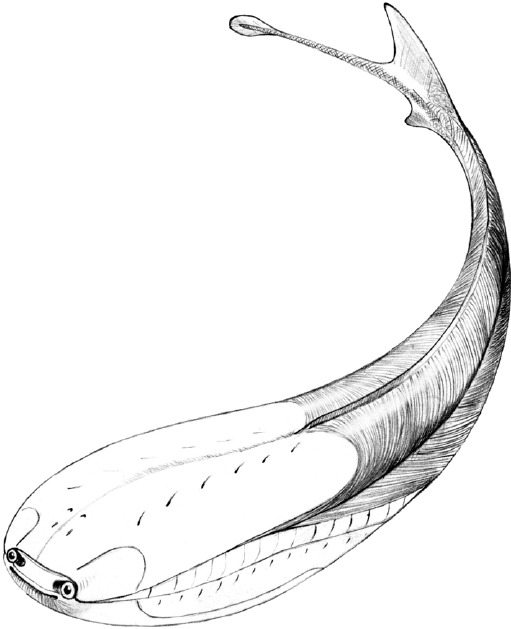
Art by Pierre Bourcier
https://onlinelibrary.wiley.com/doi/abs/10.1111/j.1463-6395.1961.tb00060.x
(payment)
5. atopodentatus
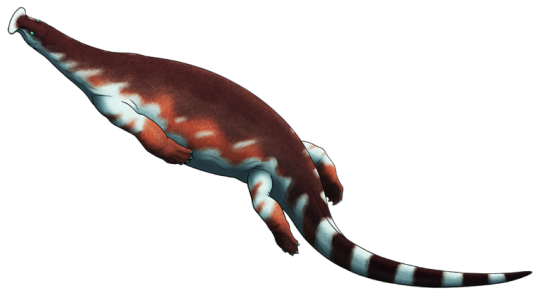
Art by Ceri Thomas
(payment)
6. Henodus
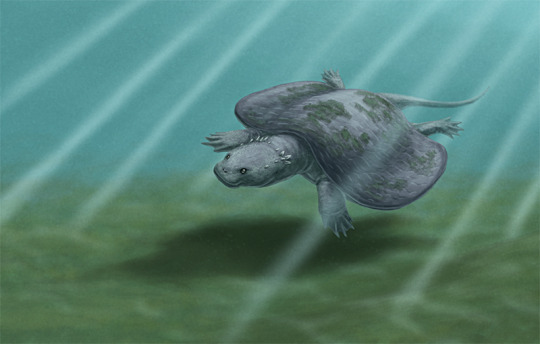
Art by Ceri Thomas
(unavailable)
7. Thylacosmilus

Art by Gabriel Ugueto
(limited access)
8. cotylorhynchus
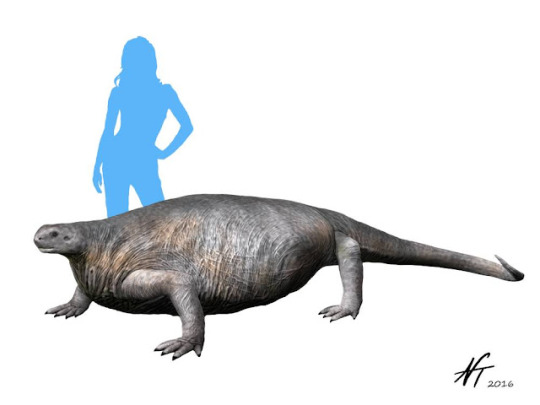
Art by Nobu Tamura
(open access currently-june 30th 2023)
9. Erythrosuchus

Art by Mark P witton
(open access currently-june 30th 2023-)
10. Tanystropheus
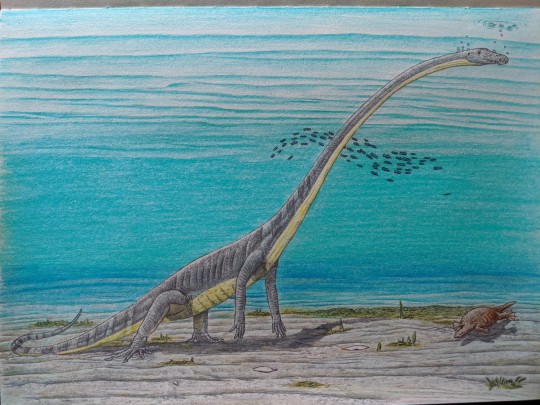
Art by Zach Branigan
(payment)
That is my top 10 unusual and unique ancient life list, most of my inclusions are quite well known but of course there are a lot more than 10.
12 notes
·
View notes
Text
I'm sick and got way too into the ID rabbit hole, so let's discuss why this guy is (Probably!) either in the Gonocephalus genus or Acanthosaura genus and why it can't be an Iguana!
I want to start by saying although I have more experience with lizards and herpetology than your average person I am not an expert.
Where better to begin than with the teeth, the most gremlin-like part of this guy! This animal has very shark-like teeth which while on their own might not be very informative, combined with a few other traits lets me ID this tooth type as acrodont. Now acrodont teeth are when the tooth itself is fused to the jaw bone which is different from our tooth attachment style as mammals, socketed thecodont teeth.
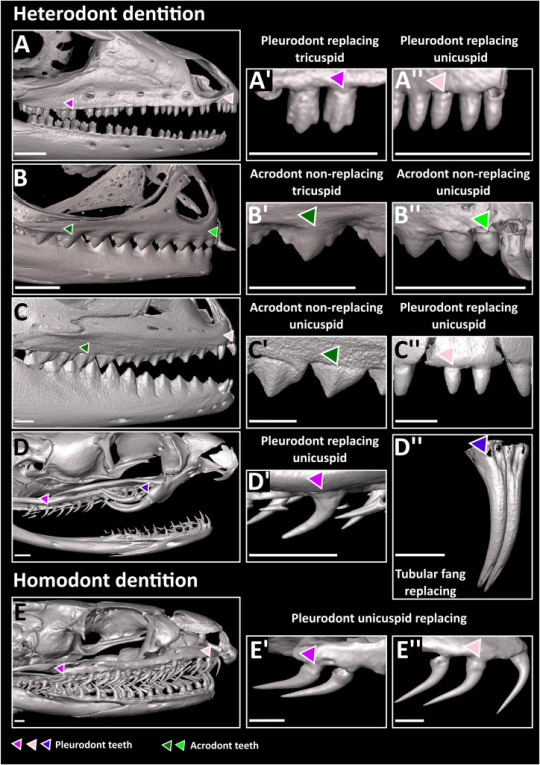
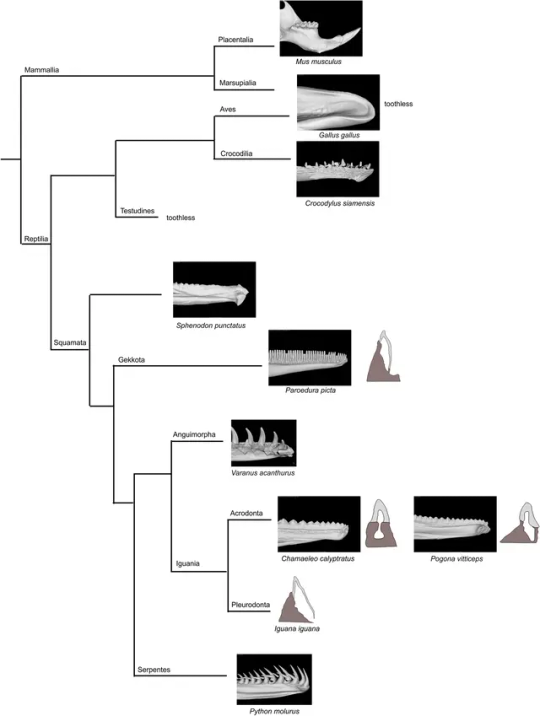
Figures from Razmade et al., 2023 and Kavková et al., 2020
This is also different from Iguanas, which have Pleurodont teeth like most other lizards. In fact, acrodont teeth are somewhat rare across squamates and are really only in the clade Acrodontia (and some amphisbaenians but this is definitely not an amphisbaenian, if you look them up you can see why)! Acrodontia includes two clades, agamids and chameleons which narrows our search down by a lot. However, we can also see in the picture that this animal doesn't have zygodactyl feet like chameleons so it must be some sort of agamid.
Now agamids are very widespread and diverse, in fact, bearded dragons, uromastyx, thorny dragons, sailfin lizards, and frilled lizards are all agamids, which means that although we narrowed down the clade there are still plenty of candidates. This is where we need to be a bit creative to get whatever information we can from the picture before we sort through the agamid family tree. This animal has green-brown skin and sparse patterning. What patterning it does have is subtle striping on the tail and body. What is notable are the very long arms and legs compared to the body size, and the tall spines/comb along the animal's back extending from the base of the animal's head to the base of its tail. It's very interesting IMO what this animal doesn't have. It doesn't have ornamental scales on its head or cheeks, nor does it have a brightly colored neck (although because we don't know the animal's age we can't rule out that it is some sort of immature animal) It also has rougher/keeled scales on its legs, belly, and tail. Honestly... that doesn't give us a whole lot of information so from here it was a lot of sifting through the agamid family tree.
What I ended up finding was that they seem pretty similar to taxa in the Gonocephalus genus like the Borneo forest dragon or Bell's forest dragon. However, some other sleuths have identified them as the Acanthosaura genus like the mountain horned lizards. I think that both of these are reasonable IDs (biased lol) but let's go over a few of the differences and why we ended up at these clades. For starters, these genera are actually pretty closely related, they're both in the clade Draconinae which includes taxa from southeast Asia and Oceania, and the really cool genus of gliding lizards Draco!
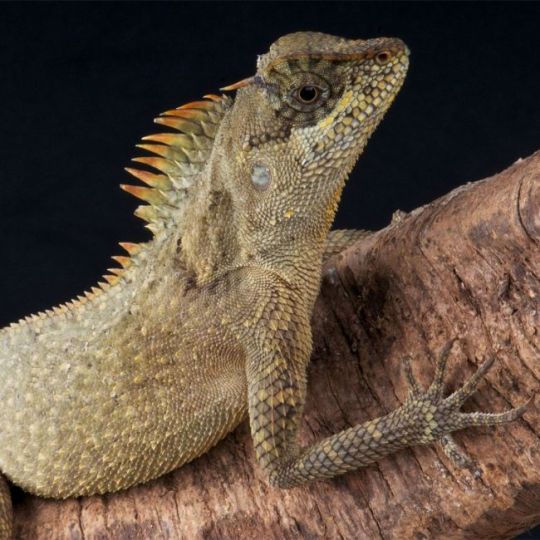
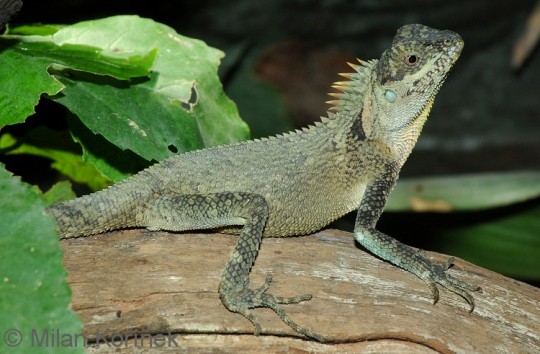
(Acanthosaura capra photo (source/source)(source))
The most likely candidate in the Acanthosaura genus is A. capra, aka the green pricklenape or horned mountain dragon. These animals are often kept in the pet trade, which is one of the reasons they might be pictured chowing down on someone's sweatshirt sleeve (some people in the pet trade also have A. nataliae, A. crucigera, A. lepidogaster, and A. armata but their coloration and spines are different). Many traits fit, as horned mountain dragons have long legs compared to their body size, a tall comb/ tall spines over their nuchal (neck) region, and keeled scales in the same places as the picture. The reason I don't think that it's a mountain dragon is that mountain dragons don't have their spines extending the length of their back, and they also possess a keratinous spike (the horn of the horned dragon) at the back of their eye ridge, which is not seen in this picture. However, again we don't know the age of this animal and the spike/horn doesn't show up in every picture I've seen of horned mountain dragons so I think this is a perfectly reasonable ID for this animal with our available information
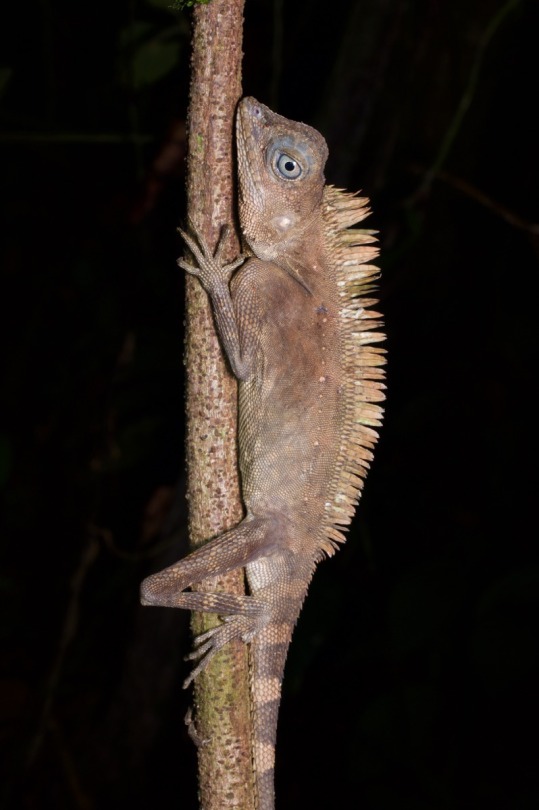
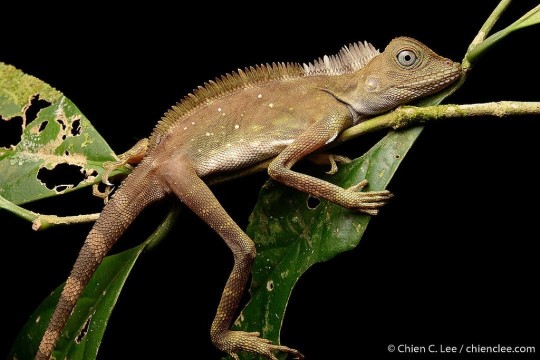
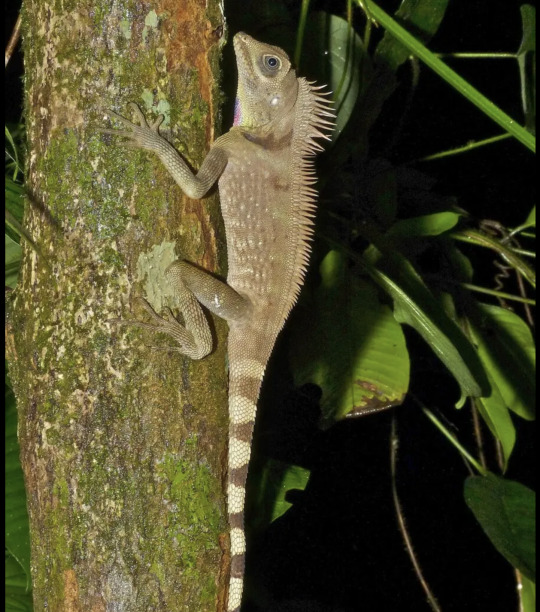
(Gonocephalus bornensis (source) (source)) (Gonocephalus bellii (source))
There are a few possibilities in the Gonocephalus genus (also called angle-head lizards or forest dragons) but not many, and it additionally seems like these guys aren't commonly kept in the reptile trade. It seems like Bell's forest dragon, giant forest dragon, and chameleon forest dragon are the more common dragons in the pet trade from this genus but it is very hard for me to find info on how common they are without diving in which I don't have time for so treat this with a grain of salt. This forum and this website both have info on keeping mountain and forest dragons but none of them mention the Borneo forest dragon which makes me sceptical bout my first ID. It seems unlikely if no one keeps them in captivity! So while it looks most like a Borneo to me it would probably be more likely to be a Bell's forest dragon if it is in Gonocephalus. Nonetheless, The reason I think this guy fits with forest dragons is because of the extended comb/spines that stretch from the back of the head all the way to the base of the tail (the perspective makes it difficult to make out but IMO the spines extend all the way) as well as the coloration (look at those tail stripes and the colors!). This is seen in Gonocephalus but not Acanthosaura, but again we have limited info and either hypothesis is reasonable. In fact, I tracked down the original reddit thread that this was posted in and the IDs were either Acanthosaura or Gonocephalus. There are even more threads with this exact picture and ID threads of Gonocephalus that look like the animal in this pic. I think that this is as far as we can narrow it down without any additional evidence like the location of the pics or more pics posted from the pet owner.
Anywho, thanks for bearing with me in this thread.
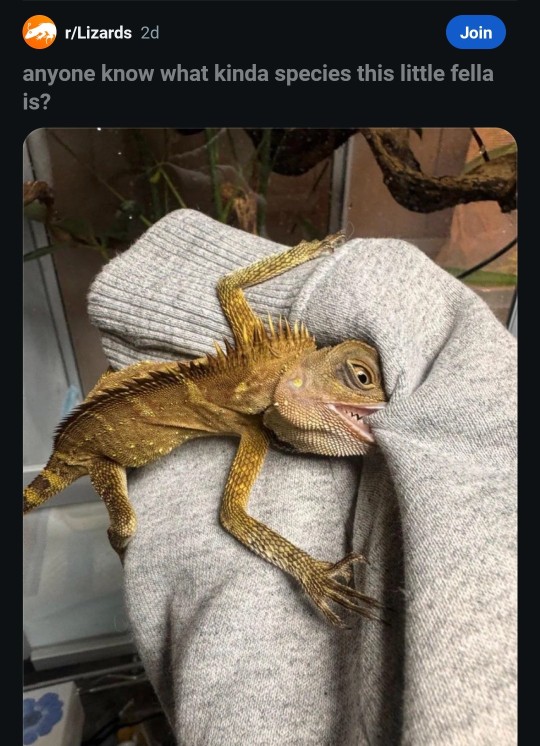
Dude
18K notes
·
View notes
Text
Mod 4 General Topics
Subclass Prototheria
Primitive, oviparous mammals.
Has a single order, Monotremata.
Confined to the Australia region.
Ex: Platypus and Spiny Anteater.
Has reptilian, avian, and mammalian affinities along with some other peculiar characters.
Reptilian affinities: Presence of Cloaca, Body temp. not constant, can withstand starvation for a long period, and eggs are large with a leathery shell
Avian affinities: Shape of platypus beak resembles a duck bill, teeth are absent and feet are webbed.
Mammalian affinities: Body covered in hair, skin richly glandular, a typical mammalian diaphragm divided the body cavity, heart 4-chambered, and presence of milk glands secreting milk.
Peculiar characters: Presence of tarsal spurs in male, milk glands derived from sweat glands and without teats, temporary abdominal marsupial pouch in female during breeding season, and the right ovary is smaller and usually functionless.
Dentition in Mammals
Arrangement of teeth in vertebrae is termed dentition, teeth are most specialized in mammals.
Teeth play an important role in everyday life of animals. They
1. Grasp and hold prey or food in the mouth cavity
2. Serve as a grinding mill for chewing food.
3. Serve as weapons for offence or defense to tear organs.
I. Shape of Teeth: teeth can be differentiated into homodont or heterodont.
Homodont teeth are all similar in shape and size, common in vertebrate other than mammals.
Heterodont teeth are dissimilar in shape and size. They are distinguished into several types such as incisors, canines, premolars, and molars. The differentiation depends on the nature of food eaten and the manner of securing it.
II. Attachment of Teeth: The manner of attachment of teeth at the bases with the jaw bones varies.
Acrodont: Teeth are attached to the free surface or summit of the jaw bone. Can break easily but also are replaced. Ex: shark
Pleurodont: Teeth are attached to the inner side of jaw bone by their base and well as one side. Ex: lizard
Both of the above are rootless, nerves and blood vessels enter the pulp cavity along the lateral side.
Thecodont: Teeth have well developed roots implanted in deep individual pits called theca in the jaw bone. Ex: mammals
III. Succession of Teeth: According to their permanence or succession:
Polyphyodont: Teeth can be replaced an indefinite number of times during their life. Ex: Lower vertebrates
Diphyodont: Teeth develop in two successive sets, common in mammals.
The first set are called milk teeth, they erupt after birth in most but in bats they form and shed before birth. Milk dentition has no molars.
Milk teeth are later replaced with permanent teeth which last throughout life. Can't be replaced if lost. Anteaters have more milk teeth than perm.
Monophyodont: Only one set of teeth develops, found in some mammals like platypus.
IV. Kinds of Teeth: 4 types, incisors, canines, premolar, molars.
Incisors: The front teeth which are borne by the premaxillae in upper jaw and tips of dentaries in lower jaw. They are single-rooted, monocuspid and long, curved and sharp-edged. They are adapted for seizing, cutting and biting
Canines: A single canine tooth occurs in each half of each jaw, just outside the incisors. Upper canines are the first teeth on maxillae. Canines are generally elongated, single rooted and with a conical sharp monocuspid crown. They are meant for piercing, tearing, offence, and defence.
Cheek Teeth: includes both premolars and molars. Their crowns have broad surfaces with ridges and tubercles meant for crushing, grinding and chewing.
Premolars: usually have two roots and two cusps and are represented in milk dentition.
Molars: generally have more than two roots and several cusps, do not have milk predecessors.
V. Dental Formula:
The number of teeth varies in different
species. However, enough teeth are constant and characteristic for every species of mammals. Therefore the number of teeth in a species can be represented by an equation called the dental formula.
Since two halves of each jaw are identical, only the teeth of one side are recorded. Those of the upper and lower jaws are separated by a horizontal line. Kinds of teeth are denoted by their initial letters: i, c, pm and m. Number of teeth shown in the formula multiplied by 2 gives the total number of teeth in a species.
Examples below
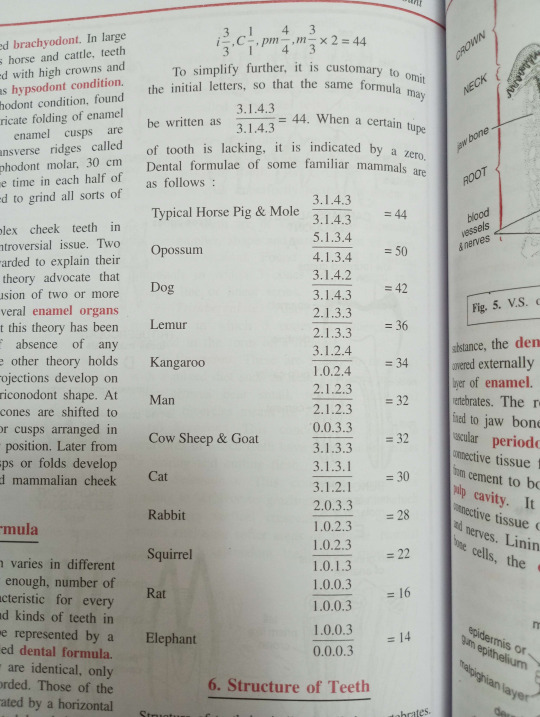
VI. Structure of Teeth
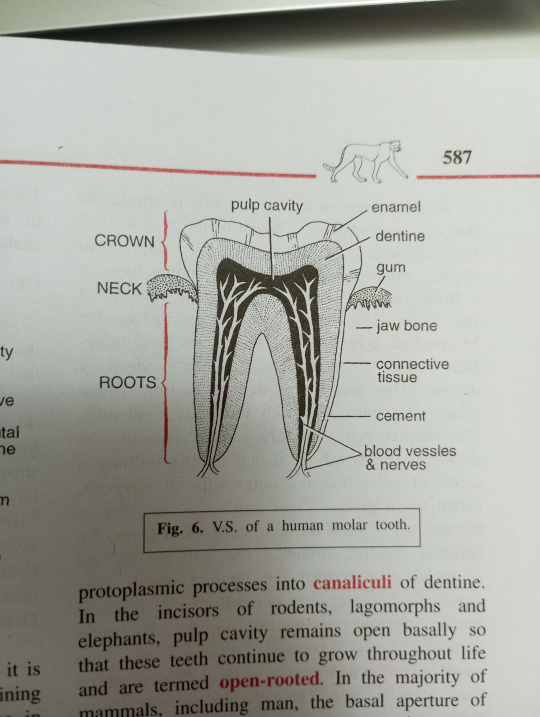
Aquatic Adaptations in Mammals
Mammals are primarily terrestrial animals, but some of them have secondarily adopted an aquatic mode of life. All of them still breath air though lungs.
Some have reverted to water because of extreme competition for food and shelter on land.
Aquatic adaptations fall into 3 main categories: modification of original structure, loss of structure, and development of new structure.
Modification of Original Structure:
1. Body Shape: Their external bodies have adapted into a fish like form with an elongated head, indistinct neck, and a tapering streamlined body which offers little resistance and swims rapidly.
2. Large size and weight: The larger size reduces skin friction and heat loss, but creates no problem for support in water due to buoyancy.
3. Flippers: Forelimbs are transformed into skin-covered unjointed flippers which have no separate fingers, they can move as a whole at the shoulder joint. Flippers serve as balancer and provide stability.
4. Hyperdactyly: Extra digits, up to 14 or more, serve to enlarge the surface area of the flipper for greater utility when swimming.
5. High and Valvular nostrils: Nostrils are placed far back on the top of the head so the animal can breath hair without having to raise it's head out of water too much. They can also be closed by valves as they dive.
6. Mammary ducts: During lactation, ducts of mammary glands dilate to form large reservoirs of milk which are pumped directly into the mouth of young by the action of a special compressor muscle. This allows suckling of young underwater.
7. Oblique diaphragm: An oblique diaphragm makes the thoracic cavity larger, dorsal, and barrel shaped, providing more space for lungs to expand.
8. Large lungs: Large and highly elastic lungs ensure taking in the maximum amount of air in before diving down. Like swim bladders in fish, the dorsal lungs also serve to maintaining a horizontal posture while swimming.
Loss of Structures:
Most hair is lost with the exception of some sensory hairs on snout or lips. Pinnae absent too. Both may obstruct the even flow of water over body surface and interfere with the speed and elegance of movement through water.
Eye cleansing nictitating membranes, lacrimal glands, and every other kinda of skin glands are absent because they are useless under water.
Skin loses its muscles and nerves due to thickening and immobility.
Hindlimbs are only represented in fetus as little nobs, disappear in adults.
Pelvis is rudimentary.
Fingernails are absent but present as traces in fetus.
Scrotal sacs are absent as testes remain inside the abdomen.
Development of New Structures:
1. Tail flukes: the tail develops large, lateral or horizontal expansions of skin called flukes. They are not supported by fin rays. Their up and down stroke both propel the body in water and help in rapid return to the surface.
2. Dorsal fin: An unpaired adipose dorsal fin without skeletal support, serves as a rudder or keel.
3. Blubber: The thick subcutaneous layer of fat. It compensates for the lack of hair by acting as a heat insulator. It also provides a ready reservoir of food and water during emergency. The fat also reduces the gravity of the animal and imparts buoyancy.
4. Harderian glands: Eyes under water remain protected by a special fatty secretion of harderian glands.
Flying Adaptations in Mammals
Flight can be seen in two ways in mammals: gliding and flapping.
Gliding is seen in flying lemurs and squirrels while flapping is seen in bats.
Gliding Adaptations:
The body is elongated, flattened and streamlined. The limbs are long and equal, tail is long and gradually tapering.
There is a double fold of furred skin called patagium or parachute membrane, stretched on either lateral side between neck, limbs, body, and tail.
Sometimes it it reinforced with a cartilaginous rod springing from the elbow or wrist.
Flapping Adaptations:
Bats are the only mammals with true and sustained flight effected by the flapping of wings. To adapt, radical changes have taken place internally in their skeleton and musculature. Their skill has been adjusted in an exaggerated manor too.
1. Wings: Wings or patagia are paper thin, elastic membranes which are extensions of leathery skin from the lateral sides of body, legs, and tail. The forearm is greatly elongated, carrying a hand with 5 very long fingers.
The first finger, the pollex, is short, free, and sharply clawed. The other 4 fingers are clawless (sometimes the 2nd is clawed), enormously lengthened and embedded in the wing web to support it. The fingers act like the ribs of an umbrella which opens and closes the wing and keeps it taut when expanded.
In most bats, an inter-femoral membrane also encloses the tail, it extends between the hindlimbs. A spur of bone, the calcar, projects from the tarsus of each foot. And a similar ante-brachial membrane connects the neck with the humerus bone of upper art. With these, there is a continuous and uninterrupted parachute of skin around the bat's body.
2. Legs: The hindlegs are small, weak, and have sharp tow claws used for suspending the bat upside down from a branch or perch while resting. Knee joints are pointed backwards instead of forwards, it helps in maximum spread of wing membrane.
3. Tail: Tail is variable in size. When well developed, the tail supports the inter-femoral membrane and acts as a break when flying. It also is used as a pouch for holding food or prey. May even be used as an aerial cradle for a new born bat.
4. Teeth: Milk dentition, Young are often born with small hook-like or needle-like teeth, they are supposed to serve the young for gripping firmly to the maternal teats while she is flying.
5. Senses: bats are extremely modified for nocturnal flight. They can fly in the dark and avoid obstacles with echolocation, their ears are supersensitive.
0 notes
Text
Scared Noose - Renounce the Flesh (full album, 2023)
youtube

Straddling the not-so-fine lines between doom, black and death metal and giving the mixture a steroid boost of stenchy punk mentality, Ireland's Sacred Noose launch what can only be described as an assault on the senses with their debut EP 'Renounce The Flesh'. A gigantic bog mummy comprised of dissonant chunky riffs, screams, blasts and grooves, it sinisterly perches among such sonic abominations as Body Void, Alkerdeel, Thecodontion and Winter who on one hand welcome it to the fold, but also keep an eye on the new arrival cause it kinda creeps them out. Safe to say this EP is absolutely delicious for those of us who appreciate the sound of sharpened teeth gnashing and rusty instruments scraping on the floor. Welcome to the sinister choir, withered ones.
#ABMN#RABM#sacrednoose#antifascistblackmetal#avantgarde#blackeneddeathmetal#deathdoom#deathmetal#doommetal#blackmetal#warmetal#experimental#dissonant#Youtube
0 notes
Audio
Listen/purchase: Thecodontion / Ceremented by Thecodontion / Ceremented
0 notes
Text
Structure of tooth:
It has 3 regions.
1.Crown – Part which project above gum
2.Neck - Part surrounded by gum
3.Root - Part embedded in bone, the incisor and canine and lower premolar have one root, upper premolar and lower molar have 2 roots and upper molar have 3 roots.
Tooth consists of enamel which is the hardest part of human body. It covers the dentine of crown. Dentine has many canaliculi that pass radially from the pulp cavity. Cement covers root of tooth. Periodontal membrane covers cement and fixes tooth in socket (Thecodont).
Inside tooth, there is pulp cavity containing mass of cells, blood vessels and nerve constitute pulp. It is for growth of tooth. Dentine forming odontoblast and enamel forming ameloblast cells are also present.

0 notes
Text
skibidi amoeba. skibidi baptistry. skibidi thecodont. skibidi ankylosis. skibidi timbale. skibidi guacharo. skibidi didapper. skibidi dumbass. skibidi gurge. skibidi multiculturalism. skibidi counseling. skibidi scissors. skibidi microcode. skibidi goldbeater. skibidi camerawork. skibidi seethe. skibidi citizeness. skibidi cuvée. skibidi anthropophagite. skibidi dumper. skibidi pyrophobia. skibidi aminotriazole. the skibidi possibilities are skibidi endless
kind of obsessed with skibidi toilet. just conceptually
6 notes
·
View notes
Video
youtube
THECODONTION-NUNA
1 note
·
View note
Photo

Thecodontion/Vessel of Iniquity – The Permian-Triassic Extinction Event (2021)
#Thecodontion#Vessel of Iniquity#The Permian-Triassic Extinction Event#2021#black metal#avant-garde metal#avant garde metal#death metal#black/death metal#black death metal#death/black metal#death black metal
1 note
·
View note
Photo

Thecodontion - Supercontinent
8 notes
·
View notes
Photo

Thecodontion | Supercontinent | 2020
Italian Death Metal
Artwork by Stefan Thanneur
https://thecodontion.bandcamp.com/album/supercontinent
#Thecodontion#Supercontinent#Italy#Italian Death Metal#Death Metal#Prehistoric Death#music#band#art#artwork#artist#Stefan Thanneur
8 notes
·
View notes